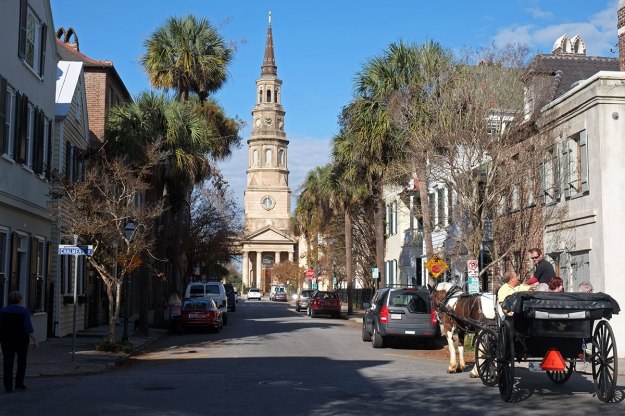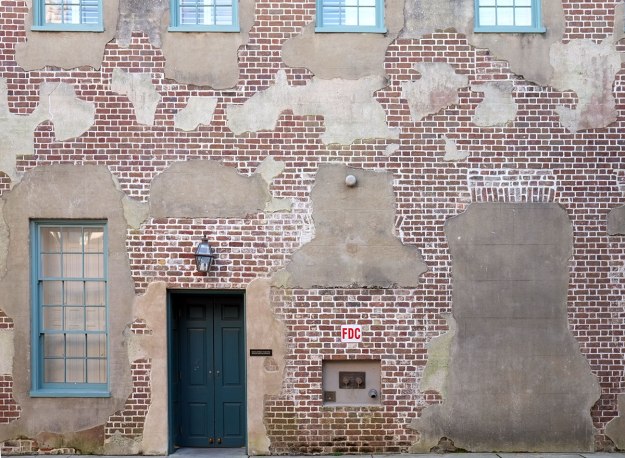A critical index for appreciating a city on our trip is the cuisine / architecture ratio; when it gets too low, Greta is miserable. Charleston is a place where we might have run into serious trouble, as the first day we were there I dragged her all over the historic district looking at housing. (Housing is even worse in her view than Architecture, as Architecture might involve museums which will have exhibits or art that might interest her.) Luckily the food quality in Charleston was very high, so it kept the whining to a minimum while I made her look at housing. And the intellectual payoff is that Greta now has a deeper understanding of typology than most architecture students do. 
As we moved deeper into the South, certain cultural characteristics become ever more evident. The discussion of any place or building revolved ever more around the history of what happened there, or even the intricacies of the family histories of the people who lived there. We toured the Edmonston-Alston House, and the docent spent most of her time elaborating the interconnections of the various families who had owned it. We didn’t care – we just wanted to see the house.
Charleston does have a long and interesting history – most famously as the place the Civil War started, but perhaps more important, it was the largest port for the slave trade in the country, with probably 40% of the enslaved people moving though it. That fact is not emphasized or very visible in the preserved fabric of the city, which as in most places, showcases the buildings of the rich. There are magnificent churches and public buildings. The pavilion at the end of the public market now serves a museum of the Confederacy.

The main shopping street is King Street, which has fine commercial buildings from different eras and styles filled with boutiques for the well-off retirees who seem to form a lot of the populace. (Charleston is also the best-dressed city we have visited, with the most men in suits and ties.) 

The street that organizes the map of Charleston is Broad: the major east-west street. Below it is the historic district, an almost perfectly-preserved area that is exclusively residential – no restaurants (and no public bathrooms). 
The churches of Charleston are widely varied in style too, and quite prominent. There are not many cities I can think of where the dominant elements on the skyline are the spires – Charleston has a few tall hotels and office buildings, but they are mostly kept away from the historic core. St. Philip’s Church is sited wonderfully – poking out into Church St., so it punctuates the vista from two directions. 
The Catholic cathedral is brownstone from Connecticut, something not seen often in the South. Fantastic masonry forms, I believe the spire was reconstructed later. 

Most buildings are brick with stucco, which sometimes wears off.
But for most architects, the main point of Charleston architecture is the housing – especially the single house, the type that was developed and used extensively in Charleston, being well-adapted to the hot, humid climate. A narrow house built right out to the street. Usually one room wide, with every room opening onto a porch, to facilitate cross-ventilation (an idea that probably migrated from the plantation house). The porch almost always faces south, to shade the rooms, and opens to a side yard, which varies from minimal to grand.

The entry from the street is into the porch zone, but there is usually a solid front door at this point for privacy.
Even when the porch itself might be open to the street.
The side yard is often screened with a high wall along the street, so it can function more as a private courtyard or garden (glimpsed here through the open carriage gate). 
That is the definition of the “type”, but as with all types, there are many variations on the theme, and for a typology geek such as me (and not Greta), the fun is in spotting the variants. The basic type is fundamentally asymmetrical and skewed towards the southern orientation. So what happens when architectural fashion favors symmetry? You can add a bay on the north that balances the porch to the south:
or you could do that and disguise the porch altogether making the first bay in depth an enclosed room.
Or maybe enclose that bay without going symmetrical.

A stair is sometimes added in the porch zone, which allows the type to transform into a multi-family building of flats.
The desire for more space led to some houses becoming two rooms wide.
At what point does it stop being a single house? When it is two rooms wide such as above, or when you do that and add a street entry into the house, and modify the linear nature of the porch?
Sometimes the urbanistic demands of the site led to a shift in orientation, such as here where the porch faces west, as the house addresses Broad St.
We were chatting with a builder one afternoon (there are builders and groundskeepers everywhere in Charleston – I’m not sure we ever saw an actual resident) – who directed us to Legare St. which has the most beautiful streetscape and the biggest houses. (And the most pickups belonging to the contractors.)
Along the Battery there is a beautiful park.

And the houses facing this are not single houses. Here the site demands change the type instead of the orientation (the porches still face south), and ventilation was probably adequate as the houses faced onto a large open space and waterfront.
The east side of the Battery has a seawall / promenade.
Lined with fantastic houses (such as this with a colossal order).  and you can tour the Edmonston-Alston House, which shows an evolution in and out of type. It started as a Federal style house, entered from the side yard into a central hall on the traverse axis. However, an entry door off the street was a later modification (along with some truly ghastly pseudo-Empire interior detailing).
and you can tour the Edmonston-Alston House, which shows an evolution in and out of type. It started as a Federal style house, entered from the side yard into a central hall on the traverse axis. However, an entry door off the street was a later modification (along with some truly ghastly pseudo-Empire interior detailing). 
The porch at the piano nobile level, however, is where I’d like to spend my retirement sitting.
The single house was not just for the rich – as you wander through other neighborhoods, you can see perfectly-preserved vernacular examples.
Which sometimes are modified to enclose more space; this is always an issue for commodious porches – eventually someone decides to add another room, and the side porch is gone. 
This happens with rich folks too, and probably would have become more common in the air-conditioning era if it weren’t for historic preservation ordinances. 
And just as there are mansions which tried to finesse the symmetry issue, there are more modest houses that engaged it also. 
We visited Charleston on our way south, but when we headed north after Christmas, we decided to return for another couple of days. I wanted to spend more time strolling the streets of this elegant and beautiful city, and Greta read the Washington Post article on America’s Ten Best Food Cities, and realized there was a place she had missed.

Wow : this was my favorite “architecture” post- probably because I LOVE house architecture. I’ve always wanted to visit Charleston: now you’ve convinced me that I MUST do so! Thanks.
LikeLike
Beautiful (!) and also fascinating. Makes me want to visit Charleston. Loved all the pictures.
LikeLike
Great photos of Charleston, when we were there years ago we were blown away by the residential areas, fantastic architecture and in really good shape. What we were surprised about, however, was how removed this part of the town was from the “real town” which has some serious problem with poverty, race relations, run down buildings, etc. The contrast between these two parts of the city is remarkable. Still, the lovely parts of town are lovely….
LikeLike